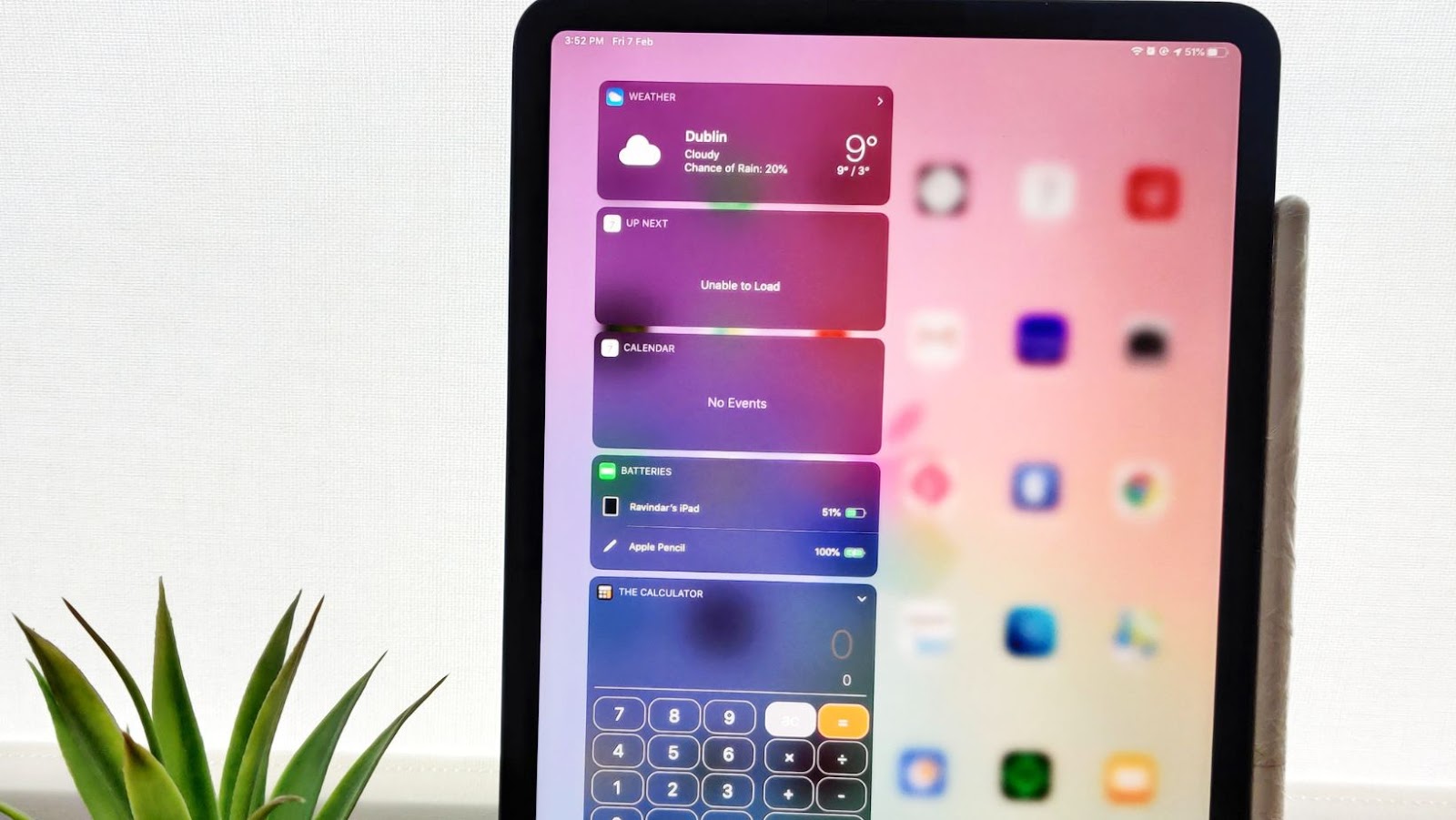

Apple has recently announced that their upcoming iPad Air will adopt OLED in 2022; furthermore, the iPad Pro models will remain exclusive to Mini-LED.
This article will explore why this next-gen display technology is so important.
Overview of OLED and Mini-LED technology
Organic Light-Emitting Diodes (OLEDs) and Mini-LEDs are the latest display technologies that offer a more efficient and brighter image than traditional LCDs. OLEDs emit light from an organic compound layer. At the same time, Mini-LEDs use a small array of hundreds or even thousands of LEDs to produce better contrast ratios, higher brightness, and improved dynamic performance.
OLED has become the standard on smartphone displays, with Apple’s iPhones now sporting OLED panels. On tablets, Apple used LCDs until 2020. Then, in 2021, the company released its first iPad with an OLED display: the iPad Pro 12.9-inch (5th generation). This was followed by the iPad Pro 11-inch (5th generation).
The upcoming iPad Air 4 is also expected to feature an OLED panel, not mini LED technology, as previously speculated by many industry analysts. The Mini-LED technology is expected to remain exclusive to the high-end model iPad Pros.
OLED technology offers various advantages to LCD screens, such as thinness and flexibility, wider viewing angles, faster response time, and a higher contrast ratio for deeper blacks, even at lower settings. In addition, they offer more vibrant colors and reduced power consumption. Unlike LCD screens — no backlight is required since each pixel can be independently lit or left off for perfect blacks when desired for brighter colors overall.
Mini LED stands alongside another display tech, such as micro-LED, in terms of offering high brightness levels along with increased dynamism which allows it to deliver better contrast levels than traditional LED screens when displaying both light and dark shades simultaneously onscreen at once – thus providing users with an overall better experience while watching movies or playing video games on these devices. In addition, combining both technologies gives users crisper image quality while saving battery life due to their better efficiency over conventional LCD panels found on most devices today.
OLED Technology
Many devices have already adopted OLED technology and are set to become even more popular in the coming years. For example, OLED technology is currently being employed in the iPad Air and is expected to remain exclusive to the iPad Pro models in 2022.
This section will discuss the advantages and disadvantages of OLED technology and why it is becoming increasingly popular in the electronic industry.
Advantages of OLED technology
OLED technology has many advantages that make it attractive for consumer products, especially displays and lighting. Compared to conventional LCDs, OLEDs offer improved picture quality, smoother motion, and a thinner profile. They also provide enhanced responsiveness, better viewing angles, wider color gamut coverage, lower energy consumption, and faster refresh rates.
Some of the more unique benefits of using OLED technology include that they can produce stunningly vibrant and more accurate colors than standard LCDs. They also have an ultra-thin profile, making them ideal for use with slim and compact devices such as smartphones or tablets. In addition, the slimness of OLEDs allows manufacturers to make thinner devices with a very minimal bezel size. This offers the user a larger display area in a smaller package without compromising image quality or power consumption.
In addition to their excellent picture quality and small size profile, OLED technology is also known for its fast response time. It translates into smooth images without tearing or blurring when users play games on their device or quickly scroll through ideas. Furthermore, they offer wide viewing angles so everyone sharing the display can enjoy the same level of image clarity from any angle. Finally, due to their low energy consumption, more battery life is available for users on their portable devices, making them highly efficient displays without compromising performance levels.
OLED technology offers higher power efficiency than conventional LCDs for mobile and large-screen TVs during operation and when turning off/on. Moreover, with word that Apple’s iPad Air will be adopting OLED in 2022 while Mini-LED will remain exclusive to iPad Pro models due out later this year, it seems clear that this versatile technology will continue making strides into even more devices for consumers’ multimedia needs in 2021-22.
Disadvantages of OLED technology
Despite the clear advantages of OLED technology, there are also some significant disadvantages. Firstly, it is generally much more expensive than LCD technology, which can impede its adoption for general-use applications. Secondly, OLED panels tend to deteriorate in terms of quality over time and it may even be possible for pictures to appear washed out over the long term. This means that techniques such as automatic brightness adjustment must be used to ensure the panel remains at optimal performance levels.
The iPad Air, set to adopt OLED technology in 2022, will likely mitigate some of these disadvantages through higher quality components. However, this does not address other issues, such as power consumption. Additionally, Mini-LED technology has a far longer expected lifespan and will offer superior visual performance on iPad Pro devices due to its increased pixel density compared to traditional LEDs.
2022 11-Inch iPad Pro to Feature Mini-LED Display, Not Just 12.9-Inch Model
Mini-LED technology is a form of LED lighting smaller than standard LED lighting and offers improved visibility, brightness, and contrast. Apple has recently adopted it in its iPad Pro models. It is set to become more widely available shortly, with rumors suggesting that the iPad Air could adopt OLED technology in 2022.
Let’s take a closer look at the advantages of this innovative technology.
Advantages of Mini-LED technology
Mini-LED technology offers a unique combination of advantages over traditional LED technology. As the name implies, mini-LEDs are much smaller than regular LEDs, allowing them to be packed into a panel in much greater numbers. Mini-LEDs can be combined with other technologies, such as OLED and LCD, to create displays that offer higher resolutions and improve color accuracy and contrast ratios. Additionally, mini-LEDs can result in brighter screens with a higher peak brightness than many competitors on the market.
Apple has decided to adopt some Mini-LED displays for its iPad Pro models due to their improved latency and refresh rate. Apple has implemented unique features that take advantage of the latencies between updates on normal LED displays, so by having more mini-LEDs this improves responsiveness from one update frame to the next. Hence why Apple’s recent iPad Pro models have made such giant technological leaps in terms of performance aspects for supporting users who want or need faster responses or fluidity when interacting with an iPad’s touchscreen, input devices or when playing certain types of games that require split second reactions. Furthermore, these devices also have shorter response times which enable more control when it comes to activities such as creating art projects that require precision brush movements across digital canvases etc..
Apple also plans to make use of mini-LED backlighting systems for its upcoming iPads which use OLED/LCD panels in order to get around some of OLED’s inherent drawbacks when dealing with motion blur issues while enjoying movies or performing tasks where smooth image rendition is essential – this is due to LCD panels being pinned with multiple pixels that can help reduce the smearing effects. Additionally, these backlighting systems will improve the strength and power efficiency ratio compared to those boards without mini-led’s used since they don’t require as many coils and current for their luminescence production.. With results that demonstrate clear improvements when it comes down fast action sequences used often by content creators via iMovie or Final Cut editing programs on iPads for example, users certainly benefit from these slimline yet functional designs found within Apple’s latest hardware offerings – plus battery life should last longer too!
Disadvantages of Mini-LED technology
Mini-LED technology has some noteworthy drawbacks that must be taken into consideration. The most significant downside is the cost, which is significantly higher than OLED or LCD displays. Mini-LEDs are also more difficult to produce, requiring a complex manufacturing process for each individual device. Additionally, the number of available brightness levels is limited, and the power savings are not as significant as with OLED displays.
Finally, Mini-LEDs typically only last for a certain number of hours of usage before needing to be replaced. Though this may not necessarily be an issue in devices such as iPads where battery life is generally good, it could prove problematic with other devices such as TVs or laptops that require longer-term use. As with OLED technology, the limitations of Mini-LED should continue to be weighed against its benefits when making purchasing decisions.
iPad Air to Adopt OLED in 2022
Apple is reportedly set to release an updated version of its iPad Air in 2022 with an OLED display, which is a huge development for mobile devices.
OLED displays offer enhanced brightness and contrast to give users more clarity and color accuracy when viewing content on their device. Mini-LED technology will remain exclusive to iPad Pro models and is currently being adopted across the board in the industry.
This article will explore the benefits of OLED and Mini-LED for iPad users.
Benefits of OLED for iPad Air
Organic Light Emitting Diode (OLED) technology has been in the works for many years, but is only now beginning to gain traction in consumer electronics products. OLED provides many benefits over traditional LCD technology such as improved power efficiency, higher contrast ratios, better color accuracy and wider viewing angles. This makes OLED a perfect fit for mobile devices like smartphones and tablets that need to stay powered longer during long days of use.
Apple recently announced plans to bring OLED display technology to their iPad Air lineup starting in 2022. This move is set to be the first major step away from LCD displays that have been seen on iPads since their inception. With the adoption of OLED technology, Apple is hoping to give users an even better experience when using their iPads, with bright, vibrant colours and deep contrast levels providing stunning visuals and an improved gaming experience while watching movies or playing games on your iPad Air.
In addition to this, Apple has also opted to stick with Mini-LED display technology for the existing iPad Pro lineup which boasts even better colour accuracy, high dynamic range capabilities and increased brightness over traditional LEDs used on both LCDs and OLEDs. By combining both technologies across their product offerings, Apple hopes to offer consumers a wide array of premium tablets at competitive price points for all uses cases, whether you are a movie buff or need enhanced performance for graphic design work or high-end gaming experiences on your iPad Pro model.

Challenges of OLED for iPad Air
Technology is constantly evolving, and when it comes to the iPad Air, such improvements play a large role in its continued potential. With iPads already having OLED screens partially in place, iPad Air is making further arrangements to transition fully to OLED screens. Despite the many benefits of OLEDs, there are some challenges and complexities associated with this shift.
One disconcerting aspect of OLED technology is its fragility; due to the thinness of the display it is highly susceptible to becoming damaged from external forces. Without proper protection and production supplies, Samsung has acknowledged that an entire display may become more worn out than LED counterparts over time.
Power consumption within the iPad air is also an inevitable limitation due to OLED referencing backlighting techniques, where individual LEDs are not possible without affecting battery life since each pixel within this newer model have a light source behind them that remains lit when needed for viewing content; creating a challenge when industry standards differ regarding power management regulations and how controls can be implemented accurately into each product.
Due to labor costs Apple must balance whether to stick with its original plan of allowing mini-LED backlighting on some future models while still being able transfer into full screen adoptions or compromise with mini-OLED references which could lead other competitors gaining traction further down the line. In addition, cost savings by maintaining mini-LEDs as its exclusive backlighting choice affects innovation capabilities that make up money but ultimately risk potential rigid implementation if no other alternative choices stay on the list – ultimately making Apple’s long-term strategies unstable.

Mini-LED to Remain Exclusive to iPad Pro Models
It appears that Apple’s iPad Air will adopt an OLED display by 2022, while their iPad Pro models are to remain exclusive to Mini-LED technology. This is highly significant due to the fact that both OLED and Mini-LED are the two most advanced display technologies currently available.
Let’s dive deeper into why these two matter and why Apple is making this decision.
Benefits of Mini-LED for iPad Pro
Mini-LED is an emerging display technology currently present in the iPad Pro lineup that enables better contrast, accuracy of colors, and power efficiency compared to other display types. Mini-LEDs are small LEDs in comparison to standard LED displays and are arranged on very thin layers of film within the display panel. This creates higher refresh rates than were previously possible with LCDs, accompanying deeper blacks and brighter whites for higher contrast. By improving the uniformity of backlighting across different zones throughout the display panel, picture accuracy is improved and RGB balance optimized. Furthermore, performance is further stabilized during peak brightness usage as mini-LEDs can be regulated more easily than traditional LED lights.
Mini-LED also offers greater energy efficiency levels than LCD displays because it is so much thinner, meaning less power is required for backlighting the individual LED zones. This not only reduces heat output from devices but also ensures a longer battery life for device owners since smaller cells are available at comparable power levels.
In addition to its many benefits for commercial markets, Apple also leverages Mini-LED on their latest iPad Pro models as well as their upcoming MacBook Pro’s with features such as True Tone color correction or True Tone Backlight control — allowing users to fine tune tone adjustment based on ambient light sources from within individual Mini-LED zones — creating never before seen sRGB coverage levels approaching 1 billion colors while reducing eye fatigue due to improved color accuracy under light shifts In any environment you’re in.
Challenges of Mini-LED for iPad Pro
Mini-LED technology offers several advantages over OLED displays, but comes with a number of challenges. These include high power consumption, high cost and potentially difficult production requirements.
Power Consumption: Mini-LED displays require substantially more power than OLED displays – up to 4x as much in some cases. This could be an issue for Apple’s iPad Pro lineup, where battery life is already a concern.
Cost: Mini-LED displays are substantially more expensive than OLED or conventional LCD panels. This could be a major factor when deciding whether to outfit the iPad Pro lineup with Mini-LED or not.
Production: Producing a quality mini-LED display involves complex manufacturing processes that may require additional specialized equipment and trained personnel. It also requires powerful cooling systems to keep the chips within these displays from overheating due to the high power required by the 10s of thousands of micro LEDs contained in them.
Conclusion
It’s too early to say definitively whether or not the addition of iPad Air models incorporating OLED displays in 2022 and Mini-LED technology exclusive to iPad Pro models can boost sales in the same way that Apple was able to benefit from the popularity of its Retina displays when they were first introduced. However, this shift towards new display technologies should provide consumers with an improved viewing experience, better battery life and more vibrant colors.
This development also speaks to Apple’s commitment to pushing the boundaries of technology, which could be enough on its own to give a noticeable boost in sales for all of its tablet products. Ultimately, it makes sense for Apple to invest in these newer display technologies – OLED and Mini-LED – as they will help bolster their reputation as leading innovators of consumer electronics products.












